Endless sea of grass
How two of the best break down large expanses of vegetation
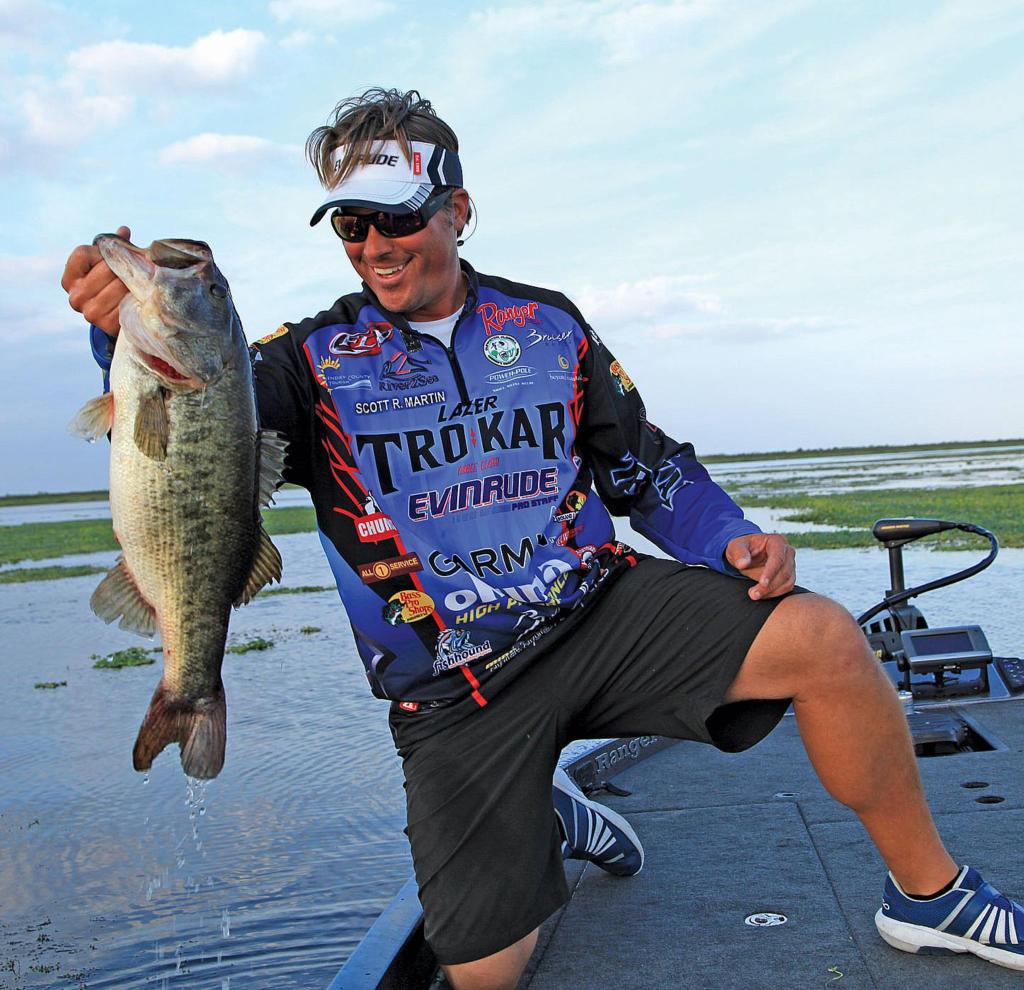
(Editor’s note: This article originally appeared in the July 2013 issue of Bass Fishing magazine. To read more compelling articles from Bass Fishing magazine each month, become an FLW subscriber member. If you’d like to sign up for a digital subscription to access articles online, click here).
Throughout the entire year, you’ll always be able to find bass relating to grass in some fashion, regardless of the fishery or depth. The primary reason: oxygen.
“Grass puts off better oxygen than any structure, and bass instinctively flock to oxygen-rich water,” says EverStart pro Randall Tharp. “Whether I’m fishing Lake Champlain, the Potomac River or the Coosa River, I’m always going to give grass a fair shot during practice. It doesn’t have to be shallow grass, either. I’ve caught some giants in 20 feet of water.”
“Grass mats provide fish with their own ecosystem,” adds Walmart FLW Tour pro Scott Martin. “From March through June, bass will get in grass to spawn, to feed and also to guard their fry in the postspawn. In the summer, I expect half of the fish to go toward deeper grass while the other half stays shallow.”
What about when the grass is virtually (or literally) everywhere on a lake? What about when bays and creeks are choked off, flats are matted up and hitting a grass bed with a Reaction Innovations Sweet Beaver is as easy as closing your eyes and making a cast?
Lakes filled with matted grass produce some of the best bass fishing in the country, but can leave even professional anglers feeling overwhelmed and unsure of where to start. If you understand why the bass use the grass, as well as the prime locations to begin your search, in what situations each species of grass is favorable to bass habitat and how to break down these large grass mats, you’ll unlock the best bass fishing of the summer.
Martin and Tharp are two of the best. They enlightened us with their strategies for mining grass for bass.
The starting point
Ask any professional angler how he establishes a solid grass pattern, and you’ll get a fairly uniform response – subtleties. Grass-fishing success is widely dependent upon your ability to notice the most diminutive environmental cues and capitalize on them at a moment’s notice.
Of course, there’s always a starting point. Here are three to consider:
Bait
“When I’m fishing thick, matted grass, the first thing I’m looking for is bait activity,” Martin says. “If there’s bait in the grass, whether it’s shad or bluegills, you can be sure there’s some big, predatory fish hanging around.”
Martin is all eyes – and ears – when he’s faced with thick grass mats. Although he does keep an eye out for flickering shad or surface swirls from big bass, he also listens for the often overlooked “sucking” sounds created by feeding bluegills. A favorite meal for bass, bluegills often come to the surface to feed on smaller prey found in matted grass. When their trademark “sucking” sounds give away their location, Martin knows that big bass aren’t far away.
Bluegills have also led to some hefty paychecks for Tharp, who keeps his head on a swivel when flipping mats. Over the years, he’s developed a keen ability to concentrate on both the surroundings and his cast at-hand.
“There’ve been a couple of times that I’ve been concentrating on flipping a mat, and out of the corner of my eye I’ve seen a school of bluegills being chased by multiple 5-pounders,” Tharp says. “Things like that are what you have to look for. If you zone out your surroundings, you’re going to miss a lot of key pieces to the puzzle.”
Color
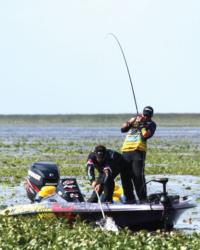 So bass always use grass – easy enough, right? Not really. It’s not always as simple as breaking out the flipping rods and going to town. Knowing what to look for can eliminate a lot of frustration when dissecting thick grass mats in the heat of summer.
So bass always use grass – easy enough, right? Not really. It’s not always as simple as breaking out the flipping rods and going to town. Knowing what to look for can eliminate a lot of frustration when dissecting thick grass mats in the heat of summer.
“I always focus on the greenest grass I can possibly find,” Tharp says. “Dead, brown grass will deplete the surrounding water’s oxygen levels and will look like a barren desert. The green grass isn’t always the easiest to get your bait through, but you’ll be rewarded.”
Martin agrees, but warns that looks can be deceiving.
“Some matted grass can die off on the surface, but still be thriving beneath the water,” Martin says. “These mats can be some serious honeyholes because a lot of folks move right past them. I’ll always give them a few flips. If I notice a bunch of lush, green grass under the mat’s surface, I’ll slow down and really pick it apart.”
Location
Instead of focusing on the specific depth of grass mats, their location relative to the deepest structure in the lake is much more essential to maximizing success in July’s brutal heat – especially when grass is abundant. When the bass finish spawning, they use creek channels as “highways” when migrating toward their deeper, summertime haunts. For this reason, finding areas where the grass mats intersect or are adjacent to deeper creek channels is key.
These mats might be shallow or deep, but again, depth is a relative term in this situation. As long as those “deeper” channels are nearby, there’s a good chance you’ll have your shot at a huge bass. In some cases, you might even abandon the mats in favor of submerged grass that connects the bait-filled mats with the deeper sanctuaries.
“The farther along you get into summer, the more you want to focus on these creek channels and the edges of main-lake points,” Martin says. “You might find some good-looking mats in the backs of creeks, but the hot, stagnant water isn’t conducive to bass habitat. In July, I want to find mats with access to nearby deeper water.”
Types of grass
Travel the country bass fishing long enough and you’ll come across a large variety of grasses, most with a number of colloquial identifiers. And on some lakes, a locally or regionally specific species of grass attracts the most and biggest bass.
But with his money on the line, Tharp tends to focus on one of two types of grass in the “typical” tournament fishery: hydrilla or milfoil.
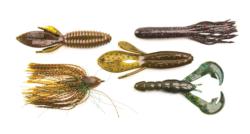 Tharp has had a lot of success fishing hydrilla mats in the South and milfoil mats in Northern fisheries. These grasses grow in thick clumps, giving the bass a perfect spot to hide and travel beneath.
Tharp has had a lot of success fishing hydrilla mats in the South and milfoil mats in Northern fisheries. These grasses grow in thick clumps, giving the bass a perfect spot to hide and travel beneath.
“Hydrilla and milfoil give bass the best of both worlds – a safe spot to shade themselves from the sun and a safe travel route,” Tharp says. “Bass travel big mazes of tunnels underneath these mats, so while the mats might look impenetrable to bass from the surface, there’s probably a bunch of big ones swimming around down there.”
Martin also likes targeting hydrilla and milfoil, but he mostly bases his vegetation targets on the water temperature and season. In the summer, he prefers to flip milfoil mats that have open spaces under thick canopies where bass can navigate and feed. Conversely, he has found that in the colder seasons, bass prefer hydrilla and hyacinth mats and shifts his targets to those types of cover.
Inside the tackle box
Ripping huge bass out of thick grass mats requires heavy equipment. Here’s how each pro approaches the task when flipping grass is the program.
Tharp’s grass-flipping gear
Tharp tries to keep his approach as simple as possible: two 7-foot, 11-inch Halo Twilite Series rods with 60- to 80-pound-test Gamma Torque braided line on his front deck – a heavy-action model with a 1/2- to 1-ounce Reins tungsten weight for thin mats and an extra-heavy model with a 1 1/2-ounce Reins tungsten weight for the more gnarly mats.
“If the bass are eating the bait on the fall, I’ll use a Strike King Rage Tail Craw, Zoom Z-Hog, a tube or a jig,” Tharp says. “It all depends on what they’re eating best that day, but if they don’t eat it on the initial fall, I rely on a Reaction Innovations Sweet Beaver.”
Martin’s grass-flipping gear
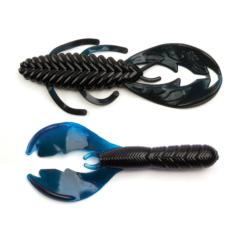 Martin doesn’t like to overcomplicate things, either: a 7-foot, 11-inch heavy-action Okuma rod with 70- to 80-pound-test braid. Based on the thickness of the grass mats, he uses a 1- to 1 1/2-ounce River2Sea tungsten sinker with a 5/0 or 6/0 Lazer Trokar TK130 Flippin’ hook on the business end. When choosing a lure, he opts for a Bruiser Baits Avenger or a Bruiser Baits Crazy Craw.
Martin doesn’t like to overcomplicate things, either: a 7-foot, 11-inch heavy-action Okuma rod with 70- to 80-pound-test braid. Based on the thickness of the grass mats, he uses a 1- to 1 1/2-ounce River2Sea tungsten sinker with a 5/0 or 6/0 Lazer Trokar TK130 Flippin’ hook on the business end. When choosing a lure, he opts for a Bruiser Baits Avenger or a Bruiser Baits Crazy Craw.
“I don’t judge my sinker weight by what the fish want,” Martin adds. “It’s all about efficiency, so I just want to get it through the mat at a high-percentage rate. If I make 1,000 flips in a day and get through the mat 900 times, I’ll probably outfish somebody who’s only getting through 600 times.”
Randall Tharp: Breaking down the bed
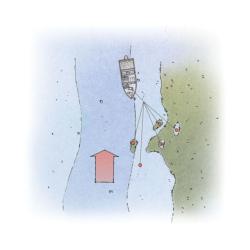 Tharp approaches most grass mats with the nose of his boat pointed into the wind or current in order to increase his boat control and avoid spooking wary bass. He targets the backside of small, subtle points and any irregularities he sees. Isolated clumps of grass in front of the primary mat have yielded huge bass for him throughout his career.
Tharp approaches most grass mats with the nose of his boat pointed into the wind or current in order to increase his boat control and avoid spooking wary bass. He targets the backside of small, subtle points and any irregularities he sees. Isolated clumps of grass in front of the primary mat have yielded huge bass for him throughout his career.
“I stay away from straight lines of grass,” Tharp says. “I want something different that gives bass something to really relate to, so I’ll fish at a fairly rapid pace until I can find these areas. When you’re searching for fish, you don’t want to get stuck fishing too slow. Covering water is extremely important and can make the difference between finding chunky fish and finding giant fish.”
Upon finding a concentration of fish, Tharp isn’t afraid to camp out and dissect the area. In July, grass-lake patterns don’t always translate well to other areas of the lake, so he invests a lot of time in finding specific areas in which he can spend the majority of his time.
Scott Martin: Breaking down the bed
Martin favors subtle differences in grass mats, while alternating flips between the outside grass-line points and interior holes and clumps. As he works the mat with his bait, he tries to make every flip 6 feet apart in order to increase his efficiency and speed. Although he makes a concerted effort to thoroughly fish each area, Martin moves rapidly until he finds an area holding big bass.
Primarily, he looks for water-flow opportunities, whether it’s current-generated or wind-stimulated current, but he sets up his boat differently than Tharp in the moving water.
“If my trolling motor is constantly crashing into the grass and spooking bass, a lot of times I’ll approach the mat from `upstream,'” Martin adds. “It allows for a silent approach as the wind drifts the boat, and I’ll just quickly drop my Power-Poles when I need to stop. It has gotten me a lot of extra bites throughout my career.”
Finding the right characteristics in the grass itself is important, but he also pays close attention to what’s beneath the mat.
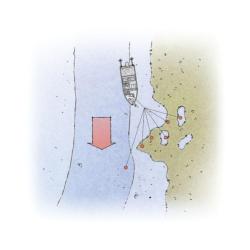 “Bass don’t always favor a muck-covered bottom, so if you can find a grass mat that has a hard bottom composition, it can end up being a real bass magnet,” Martin says. “I always pay close attention to what the bottom feels like once my bait has made it through the grass. Big bass will congregate on these areas, as will shad and other prey, so always keep a close lookout for a hard bottom.”
“Bass don’t always favor a muck-covered bottom, so if you can find a grass mat that has a hard bottom composition, it can end up being a real bass magnet,” Martin says. “I always pay close attention to what the bottom feels like once my bait has made it through the grass. Big bass will congregate on these areas, as will shad and other prey, so always keep a close lookout for a hard bottom.”
When he catches a fish, Martin makes mental notes about the area – his presentation, boat positioning and bait selection – in order to further home in on the pattern. He slows down and saturates a productive area with casts, but once a pattern is established, it allows him to bypass less productive types of areas in order to increase his efficiency.
Efficiency, when confronted with miles of thick grass, is the most dependable tool an angler has in his tackle box for locating quality fish in the vast expanse of green. And with a smart approach that takes into account bait location, grass type and bed layout, an attentive angler can quickly sniff out the sweet spots.
Veggie profile: Hydrilla
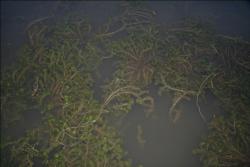 Hydrilla is a hearty, green-colored invasive aquatic plant species. Identifiable by its pointed leaves protruding from the length of the stem, it is actually native to southeast Asia, but was present in some Florida waters as early as the 1950s. It doesn’t need much to flourish, either – with just minimal light penetration it can grow 1 foot per day.
Hydrilla is a hearty, green-colored invasive aquatic plant species. Identifiable by its pointed leaves protruding from the length of the stem, it is actually native to southeast Asia, but was present in some Florida waters as early as the 1950s. It doesn’t need much to flourish, either – with just minimal light penetration it can grow 1 foot per day.
Early in the year, with lower temperatures, hydrilla grows horizontally along the bottom of fisheries. As the water temperature rises throughout the spring and summer, the plants’ stems rise to the surface to create dense canopies.
Even the smallest fragments of a plant have the ability to sprout roots and begin separate colonies, resulting in it being easily spread by boats, livewells, trailers and high winds.
Its thick root system is known to “choke” other, more beneficial native aquatic plants. Although it’s a serious headache for biologists nationwide, hydrilla provides an expansive habitat for both game fish and their prey.
Using Talons as sea anchors
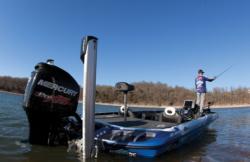 Fishing shallow grass lines and weedbeds without spooking bass can be tricky. Keystone Light pro Brent Ehrler has a good solution, providing the wind is steady and blowing consistently in the same direction.
Fishing shallow grass lines and weedbeds without spooking bass can be tricky. Keystone Light pro Brent Ehrler has a good solution, providing the wind is steady and blowing consistently in the same direction.
“If I’m fishing grass and it’s fairly windy, I’ll try to line up with the wind and use the two Minn Kota Talons mounted on the back of my boat to slow me down,” says the California angler. “How I do that is by lowering the Talons up or down to snag the grass and correspondingly drift faster or slower. This is a very stealthy way to fish shallow grass, especially, without having to use the trolling motor any more than I have to.”
To stop and fish an especially productive area, Ehrler positions the boat and lowers both Talon units temporarily until they catch bottom.